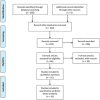Clipping versus coiling for the treatment of oculomotor nerve palsy induced by posterior communicating artery aneurysms: A comparison of effectiveness
- PMID: 34152096
- PMCID: PMC8413790
- DOI: 10.1002/brb3.2263
Clipping versus coiling for the treatment of oculomotor nerve palsy induced by posterior communicating artery aneurysms: A comparison of effectiveness
Abstract
Background: A long debate has been going on in the clinical effectiveness to determine whether surgical clipping or coiling more favorable for oculomotor nerve palsy (ONP) caused by PcomAA. We aimed to perform a study, focusing on the effectiveness of ONP induced by PcomAA after treatment of surgical clipping and endovascular coiling.
Method: Potential studies were searched on PubMed, EMBASE, Web of Science, and Cochrane Library from database inception to February 2021, and STATA version 12.0 was exerted to process the pooled data.
Results: A total of 16 articles are included in the study, hailing from the United States, South Korea, the United Kingdom, France, Germany, Korea, China, Japan, Britain, and Singapore. The results showed that the clipping group was related to a higher incidence of complete ONP recovery at follow-up (OR = 5.808, 95% CI 2.87 to 11.76, p < 0.001), the lower rates of partial ONP recovery (OR = 0.264, 95% CI 0.173 to 0.402, p < .001) and no improvement of ONP at follow-up (RD = -0.149, 95% CI -0.247 to -0.051, p = .003). In the subgroup of complete ONP recovery based on the condition of patients, clipping was associated with a higher incidence of complete ONP recovery in patients with the incomplete initial ONP (OR = 3.579, p = .020) and ruptured aneurysm (OR = 5.38, p = .020). Regarding the subgroup of complete ONP recovery based on the quality of studies, similar results also appeared.
Conclusion: Surgical clipping was more favorable to the recovery from ONP caused by PcomAA endovascular coiling due to a higher rate of recovery and recovery degree of ONP. Besides that, more evidence-based performance is necessary to supplement this opinion.
Keywords: clip; coil; oculomotor nerve palsy; posterior communicating artery aneurysms.
© 2021 The Authors. Brain and Behavior published by Wiley Periodicals LLC.
Conflict of interest statement
The authors declare that they have no competing interests.
Figures






References
Publication types
MeSH terms
LinkOut - more resources
Full Text Sources
Medical
Miscellaneous

